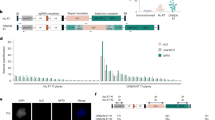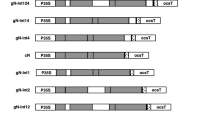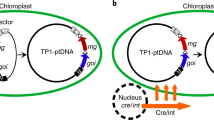Abstract
Here we show that the cis-acting genetic element aps (amplification-promoting sequence), isolated from the nontranscribed spacer region of tobacco ribosomal DNA (rDNA), increases the level of expression of recombinant proteins. Transgenic tobacco plants, transformed with expression cassettes containing the herbicide-resistant acetolactate synthase (hr-ALS) gene or the green fluorescent protein (GFP) gene fused to the aps sequence, had greater levels of corresponding messenger RNAs (mRNAs) and proteins compared to transformants lacking aps. Analysis of transgenic plants showed that aps increased the copy number and transcription of the adjacent heterologous genes and, in the case of hr-ALS, enhanced the herbicide resistance phenotype. Both the increased transgene copy number and enhanced expression were stably inherited. These data provide the first evidence that the aps sequence can be used for gene amplification in transgenic plants and possibly other multicellular organisms.
This is a preview of subscription content, access via your institution
Access options
Subscribe to this journal
Receive 12 print issues and online access
$209.00 per year
only $17.42 per issue
Buy this article
- Purchase on Springer Link
- Instant access to full article PDF
Prices may be subject to local taxes which are calculated during checkout



Similar content being viewed by others
References
Kumagai, M.H. et al. Rapid, high-level expression of biologically active - trichosanthin in transfected plants by an RNA viral vector. Proc. Natl. Acad. Sci. USA 90, 427–430 ( 1993).
Bogorad, L. Engineering chloroplasts: an alternative site for foreign genes, proteins, reactions and products. Trends Biotechnol. 18, 257–263 (2000).
Alt, F.W., Kellems, R.E., Bertino, J.R. & Schimke, R.T. Selective multiplication of dihydrofolate reductase genes in methatrexate-resistant variants of cultured murine cells. J. Biol. Chem. 251 , 1357–1370 (1978).
Stark, G. R. & Wahl, G.M. Gene amplification. Annu. Rev. Biochem. 53, 447–491 (1984).
Lengauer, C., Kinzier, K.W. & Vogelstein, B. Genetic instabilities in human cancers. Nature 396, 643–649 ( 1998).
Schimke, R.T. Gene amplification in cultured cells. J. Biol. Chem. 263, 5989–5992 (1988).
Pasion, S.G., Hartigan, J.A., Kumar, V. & Biswas, D.K. DNA sequence responsible for the amplification of adjacent genes. DNA 6, 419–428 ( 1987).
Wegner M. et al. Cis-acting sequences from mouse rDNA promote plasmid amplification and persistence in mouse cells: implication of HMG-1 in their function. Nucleic Acids Res. 17, 9909–9932 (1989).
McArthur, J.G. & Stanners, C.P. A genetic element that increases the frequency of gene amplification. J. Biol. Chem. 266, 6000–6005 ( 1991).
McArthur, J.G., Beitel L.K., Chamberlain J.W. & Stanners, C.P. Elements which stimulate gene amplification in mammalian cells: role of recombinogenic sequences/structures and transcriptional activation . Nucleic Acids Res. 19, 2477– 2484 (1991).
Stolzenburg, F., Gerwig, R., Dinkl, E. & Grummt, F. Structural homologies and functional similarities between mammalian origins of replication and amplification promoting sequences. Chromosoma 103, 209–214 ( 1994).
Hemann, C., Gartner, E., Weidle, U.K. & Grummt, F. High-copy expression vector based on amplification-promoting sequences. DNA Cell Biol. 13, 437–445 (1994).
Meyer, J. et al. Inhibition of HIV-1 replication by a high-copy-number vector expressing antisense RNA for reverse transcriptase. Gene 129, 263–268 (1993).
Kellems, R.E. Gene amplification strategies for protein production in mammalian cells. Methods Mol. Genet. 5, 143–155 (1994).
Bedbrook, J.R., O'Dell, M. & Flavell, R.B. Amplification of rearranged repeated DNA sequences in cereal plants. Nature 288, 133–137 (1980).
Phillips, R.L., Kaeppler, S.M. & Olhoft, P. Genetic instability of plant tissue culture: breakdown of normal controls. Proc. Natl. Acad. Sci. USA 91, 5222–5226 (1994).
Donn, G., Tischer, E., Smith, J.A. & Goodman, H.M. Herbicide-resistant alfalfa cells: an example of gene amplification in plants . J. Mol. Appl. Genet. 2, 621– 635 (1984).
Borisjuk, N.V. In Plant cell engineering. Results of science and technology, Vol. 9 (ed. Gleba, Y.) 73–113 (VINITI, Moscow; 1988) (in Russian).
Borisjuk, N.V., Momot, V.P. & Gleba, Y. Novel class of rDNA repeat units in somatic hybrids between Nicotiana and Atropa. Theor. Appl. Genet. 76, 108–112 ( 1988).
Hemleben, V. & Zentgraf, U. Structural organization and regulation of transcription by RNA polymerase I of plant nuclear ribosomal RNA genes. In Results and problems in cell differentiation. Plant promoters and transcription factors, Vol. 20 (ed. Nover, L.) 3–24 (Springer-Verlag, Berlin-Heidelberg, Germany; 1994).
Borisjuk N. & Hemleben, V. Nucleotide sequence of the potato rDNA intergenic spacer. Plant Mol. Biol. 21, 381–384 (1993).
Borisjuk N.V. et al. Structural analysis of rDNA in the genus Nicotiana. Plant Mol. Biol. 35, 655–660 (1997).
Volkov, R.A., Borisjuk, N.V., Panchuk, I.I., Schweizer, D. & Hemleben, V. Elimination and rearrangement of parental rDNA in allotetraploid Nicotiana tabacum. Mol. Biol. Evol. 16, 311–320 (1999).
Hernandez, P., Martin-Parras, L., Martinez-Robles, M.L. & Schvartzman, J.B. Conserved features in the mode of replication of eukaryotic ribosomal RNA genes. EMBO J. 12, 1475– 1485 (1993).
Caddle, M.S., Lussier, R.H. & Heintz, N.H. Intramolecular DNA triplexes, bent DNA and DNA unwinding elements in the initiation region of an amplified dihydrofolate reductase replicon. J. Mol. Biol. 211, 19– 33 (1990).
Haughn, G.W., Smith, J., Mazur, B. & Somerville, C. Transformation with a mutant Arabidopsis acetolactate synthase gene renders tobacco resistant to sulfonylurea herbicides. Mol. Gen. Genet. 211, 266–271 (1988).
Reichel, C. et al. Enhanced green fluorescence by the expression of an Aequorea victoria green fluorescent protein mutant in mono- and dicotyledonous plant cells . Proc. Natl. Acad. Sci. USA 93, 5888– 5893 (1996).
Borisjuk, N.V. et al. Production of recombinant proteins in plant root exudates. Nat. Biotechnol. 17, 466–469 (1999).
de Carvalho, F. et al. Suppression of β-1,3-glucanase transgene expression in homozygous plants. EMBO J. 14, 2595–2602 (1992).
Kneidl, K., Dinkl, E. & Grummt, F. An intrinsically bent region upstream of the transcription start site of the rRNA genes of Arabidopsis thaliana interacts with an HMG-related protein. Plant Mol. Biol. 27, 705–713 (1995).
Dobbs, D., Shaiu, W.-L. & Benlow, R.M. Modular sequence elements associated with origin regions in eukaryotic chromosomal DNA. Nucleic Acids Res. 22 , 2479–2489 (1994).
Brun, C., Surdej, P. & Miassod, R. Relationship between scaffold-attached regions, sequences replicating autonomously in yeast, and a chromosomal replication origin in the Drosophila rDNA. Exp. Cell Res. 208, 104–114 (1993).
Bevan, M. Binary Agrobacterium vectors for plant transformation. Nucleic Acids Res. 12, 8711–8721 (1984).
Borisjuk, N. et al. Calreticulin in plant cells: primary structure, developmentally regulated expression and intracellular distribution. Planta 206 , 504–514 (1998).
Acknowledgements
We thank C. Reichel for the GFP expression cassette and F. Petersen for help with GFP detection. hr-ALS expression cassette, and the samples of Pursuit herbicide were kindly provided by the American Cyanamid Company (Princeton, NJ). This work was supported by a grant from Phytomedics, Inc. (Dayton, NJ).
Author information
Authors and Affiliations
Corresponding author
Supplementary information
Rights and permissions
About this article
Cite this article
Borisjuk, N., Borisjuk, L., Komarnytsky, S. et al. Tobacco ribosomal DNA spacer element stimulates amplification and expression of heterologous genes. Nat Biotechnol 18, 1303–1306 (2000). https://doi.org/10.1038/82430
Received:
Accepted:
Issue Date:
DOI: https://doi.org/10.1038/82430
This article is cited by
-
Enhanced transgene expression in rice following selection controlled by weak promoters
BMC Biotechnology (2013)
-
Improved recombinant cellulase expression in chloroplast of tobacco through promoter engineering and 5′ amplification promoting sequence
Plant Molecular Biology (2013)
-
The intergenic spacer region of the rDNA in Haplopappus gracilis (Nutt.) Gray
Protoplasma (2013)
-
Developmental and environmental variation in genomes
Heredity (2009)
-
Geographically localised bursts of ribosomal DNA mobility in the grasshopper Podisma pedestris
Heredity (2009)



